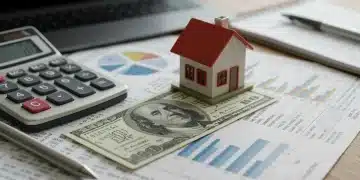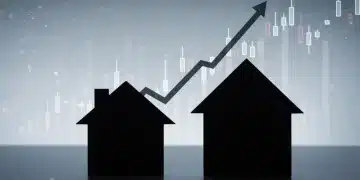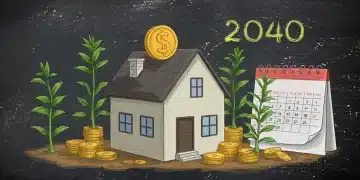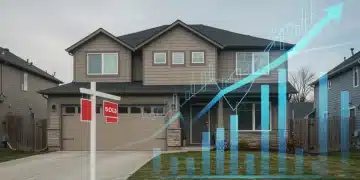Refinancing Mortgage 2025: Is 0.5% Rate Drop Enough?
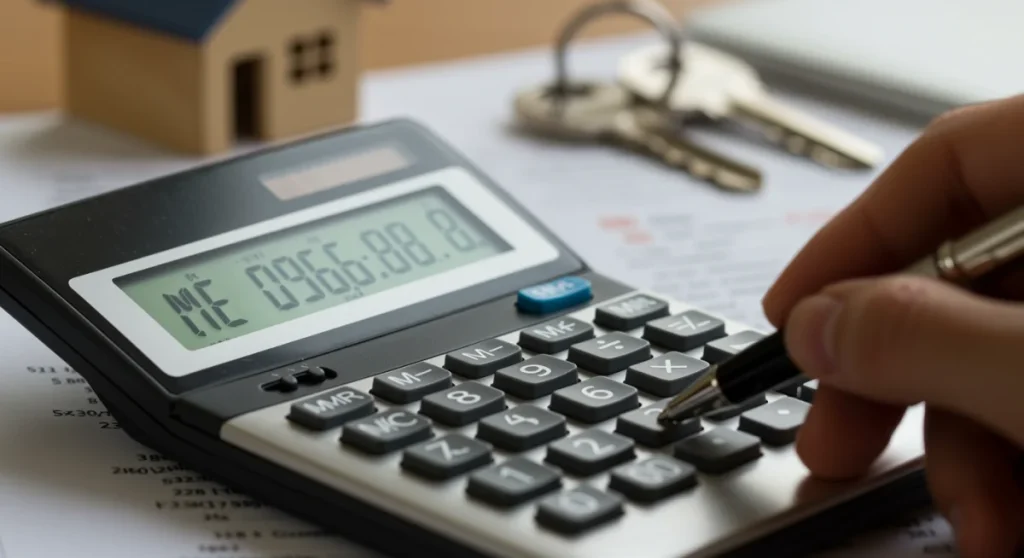
Refinancing your mortgage in 2025 with a 0.5% rate drop requires careful evaluation of closing costs against potential long-term savings to determine financial viability.
Refinancing your mortgage in 2025: Is a 0.5% Rate Drop Enough to Justify the Costs? This is the critical question many homeowners are asking as they eye the evolving financial landscape. With interest rate fluctuations always on the horizon, understanding when a seemingly small rate reduction can lead to significant savings is paramount for strategic financial planning.
Understanding the 0.5% Rate Drop Threshold
The prospect of a 0.5% drop in mortgage interest rates can seem modest at first glance, but its actual impact on your monthly payments and overall loan cost can be substantial. For many homeowners, this seemingly small percentage point reduction serves as a key indicator for whether refinancing is a financially sound decision. It’s not just about the immediate savings, but also the long-term implications for your financial health.
As of late 2024, market analysts are closely monitoring economic indicators that could influence the Federal Reserve’s decisions on interest rates for 2025. A consistent downward trend, even if incremental, could signal a favorable environment for homeowners looking to reduce their borrowing costs. The question then becomes, how does that 0.5% translate into tangible benefits against the often-overlooked expenses of a refinance?
The Mathematics of Savings
To truly grasp the benefit of a 0.5% rate reduction, homeowners must look beyond the percentage and calculate the actual dollar savings. This involves considering your current mortgage balance, remaining loan term, and current interest rate. A half-percent reduction can shave tens, if not hundreds, of dollars off your monthly payment, freeing up cash flow or accelerating equity build-up.
- Monthly Payment Reduction: Calculate the difference in your monthly principal and interest payment.
- Total Interest Saved: Project the total interest saved over the life of the loan.
- Equity Acceleration: Understand how lower payments can allow for extra principal contributions.
Long-Term Financial Impact
While immediate savings are appealing, the long-term financial impact of a 0.5% rate drop can be even more significant. Over a 15-year or 30-year mortgage term, those small monthly savings accumulate into thousands of dollars. This freed-up capital can be redirected towards investments, debt reduction, or other financial goals, enhancing your overall financial stability. The decision today impacts your financial future significantly.
Navigating Refinancing Costs in 2025
While a lower interest rate is attractive, the decision to refinance is heavily influenced by the associated costs. These expenses, often referred to as closing costs, can range from 2% to 5% of the loan amount, and they represent a significant upfront investment. Understanding these costs is crucial for determining if a 0.5% rate drop is truly enough to justify the endeavor in 2025.
Recent reports from lending institutions indicate that while some fees might be negotiable, many remain standard across the industry. Homeowners should anticipate expenses such as loan origination fees, appraisal fees, title insurance, and legal fees. These aggregated costs can quickly diminish the perceived savings from a minor interest rate reduction, making a thorough cost-benefit analysis essential.
Typical Closing Costs to Expect
Refinancing involves a variety of fees that can add up. Being aware of these helps in preparing your budget and negotiating where possible. These costs are a primary factor in assessing the overall financial benefit of a refinance.
- Loan Origination Fees: Charges for processing the new loan.
- Appraisal Fees: Cost for determining the current market value of your home.
- Title Insurance: Protects the lender and you against property title issues.
- Recording Fees: Charged by local government to record the new mortgage.
Strategies for Minimizing Costs
Homeowners have several options to potentially reduce the impact of closing costs. One common strategy is to negotiate with lenders for lower fees or to roll some of the costs into the new loan. While rolling costs into the loan means you pay interest on them, it avoids a large upfront payment. Another approach is to shop around extensively for lenders, as fees can vary significantly.
Some lenders offer “no-closing-cost” refinances, where they absorb the closing costs in exchange for a slightly higher interest rate. This option can be appealing for those who plan to move within a few years, as it minimizes the upfront financial burden. However, it’s vital to calculate if the higher interest rate negates the savings from the 0.5% drop over your expected tenure in the home.
Calculating Your Break-Even Point
The break-even point is a critical metric in refinancing decisions, especially when considering a modest interest rate reduction like 0.5%. It’s the moment when the savings from your lower monthly payments equal the total cost of refinancing. Until you reach this point, you’re essentially losing money on the refinance. For homeowners in 2025, understanding this calculation is non-negotiable.
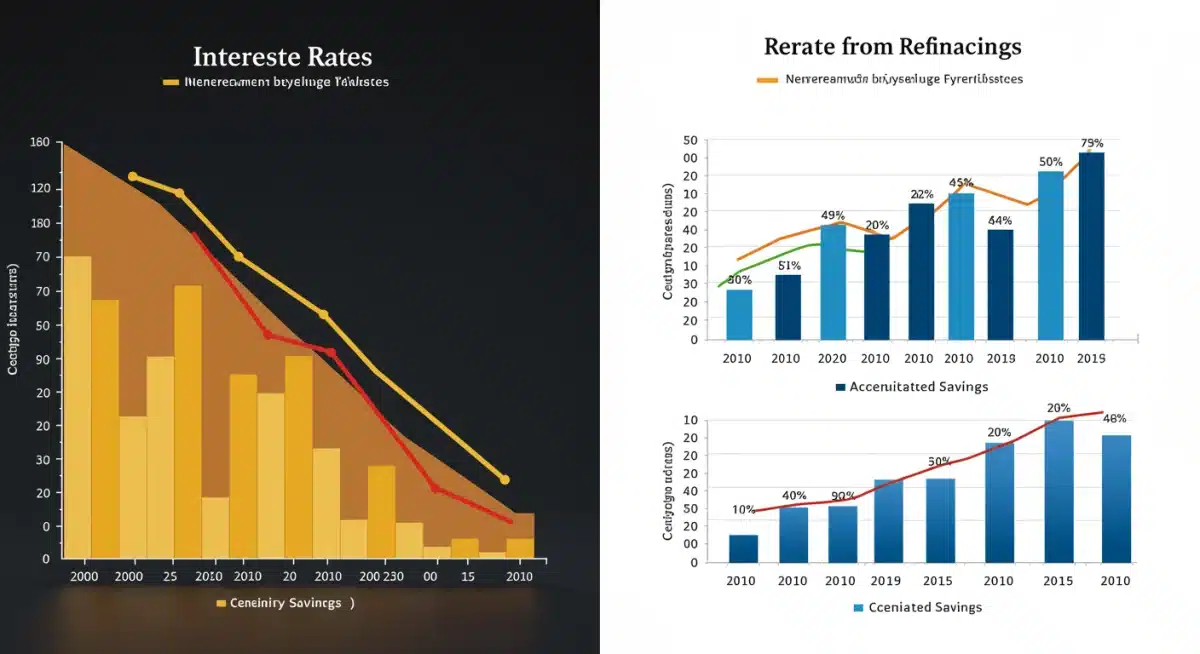

Recent financial analyses highlight that for a 0.5% rate drop, the break-even period can typically range from 18 to 36 months, depending on the loan amount and closing costs. If you plan to sell your home or refinance again before reaching this point, the refinance might not be financially advantageous. Therefore, your long-term housing plans play a significant role in this decision.
Formula for Break-Even Calculation
Calculating your break-even point involves a straightforward formula. You divide the total closing costs by the monthly savings achieved from the lower interest rate. This gives you the number of months it will take to recoup your initial investment.
- Total Closing Costs: Sum of all fees and charges associated with the refinance.
- Monthly Savings: Difference between your old and new monthly mortgage payment.
- Break-Even Point (Months): Total Closing Costs / Monthly Savings.
When a Short Break-Even is Ideal
A shorter break-even period generally indicates a more favorable refinancing scenario. For a 0.5% rate drop, aiming for a break-even point of two years or less is often considered optimal, especially if you foresee potential life changes like a job relocation or a desire to upgrade your home. A quick recovery of costs means you start realizing net savings sooner, maximizing the financial benefit of the refinance.
Market Conditions and Predictions for 2025
The housing and lending markets are dynamic, making predictions for 2025 crucial for homeowners considering a refinance. Current economic indicators, including inflation rates, employment data, and global financial stability, all contribute to the outlook for mortgage rates. As of this quarter, experts are cautiously optimistic about a gradual decline in rates, potentially offering windows of opportunity for refinancing.
The Federal Reserve’s stance on monetary policy will be a primary driver. Should inflation continue to moderate, the Fed may ease its hawkish policies, leading to a more favorable rate environment. However, geopolitical events and unforeseen economic shifts could always introduce volatility. Homeowners planning to refinance in 2025 should stay informed through reliable financial news sources and consult with mortgage professionals.
Factors Influencing Mortgage Rates
Several key factors directly influence the direction of mortgage rates. Understanding these can help homeowners anticipate market movements and make timely decisions regarding refinancing.
- Inflation: High inflation often leads to higher interest rates.
- Federal Reserve Policy: Changes in the federal funds rate impact mortgage rates.
- Economic Growth: Strong economic growth can lead to rate increases.
- Housing Market Demand: High demand for homes can also influence rates.
Expert Forecasts for the Year Ahead
Leading financial institutions and economists are offering varied, but generally optimistic, forecasts for mortgage rates in 2025. While no one can predict the future with absolute certainty, the consensus points towards a potential stabilization or slight decrease in rates from current levels. This could make a 0.5% drop more accessible and potentially more impactful for a broader range of borrowers.
However, it is essential for homeowners to remember that forecasts are not guarantees. The best approach is to monitor the market continuously and be prepared to act when conditions align with your financial goals. Setting rate alerts with lenders or financial advisors can help you capitalize on favorable shifts.
Alternatives to Traditional Refinancing
While a traditional rate-and-term refinance is often the first option homeowners consider, it’s not the only way to leverage a 0.5% rate drop or improve your financial standing in 2025. Several alternatives exist that might better suit individual circumstances, particularly if minimizing upfront costs or accessing home equity is a priority. Exploring these options can provide flexibility and tailored solutions.
For instance, a cash-out refinance allows homeowners to tap into their home equity while securing a lower interest rate, potentially consolidating high-interest debt or funding major home improvements. However, this increases your loan amount and thus the total interest paid over time. Another option is a loan modification, which can alter your existing loan terms without the extensive closing costs of a full refinance, though it typically requires financial hardship.
Cash-Out Refinancing
A cash-out refinance involves taking out a new, larger mortgage than your current outstanding balance, and receiving the difference in cash. This is a popular option for those with significant home equity who want to utilize it for other purposes.
- Benefits: Access to lump sum cash, potentially lower interest rate on the entire loan.
- Considerations: Increases total debt, extends repayment period, more closing costs.
Streamline Refinancing Options
For certain types of loans, like FHA or VA mortgages, streamline refinancing programs offer a simplified process with reduced documentation and lower costs. These programs are designed to make it easier for eligible borrowers to secure a lower interest rate without the extensive paperwork and appraisal requirements of a traditional refinance.
These options are particularly attractive if your primary goal is to lower your interest rate and monthly payment without altering other loan terms or pulling out cash. They can significantly reduce the break-even period, making a 0.5% rate drop more impactful and easier to justify.
Making the Right Decision for You
Deciding whether to refinance your mortgage in 2025 based on a 0.5% rate drop is a highly personal financial decision. It requires a thorough evaluation of your current financial situation, future goals, and a clear understanding of both the potential savings and the associated costs. There is no one-size-fits-all answer, and what works for one homeowner may not be suitable for another.
Begin by gathering all relevant financial documents, including your current mortgage statement, recent pay stubs, and credit report. This will provide a clear picture of your eligibility and potential terms. Next, obtain quotes from multiple lenders to compare interest rates, closing costs, and loan terms. Don’t solely focus on the interest rate; the overall cost and the break-even period are equally, if not more, important.
Key Questions to Ask Yourself
Before committing to a refinance, consider these crucial questions to ensure it aligns with your financial strategy:
- How long do you plan to stay in your home? This determines if you’ll reach your break-even point.
- What are your financial goals? Are you looking for lower payments, debt consolidation, or faster equity build-up?
- Is your credit score strong? A higher score secures better rates and terms.
- Can you comfortably afford the closing costs? Even if rolled into the loan, they add to your debt.
Consulting Financial Professionals
Engaging with a mortgage broker or a financial advisor can provide invaluable insights. These professionals can help you navigate the complexities of refinancing, analyze different scenarios, and offer personalized advice based on your unique financial profile. Their expertise can help you make an informed decision and avoid costly mistakes, ensuring that a 0.5% rate drop truly benefits you in 2025.
| Key Point | Brief Description |
|---|---|
| 0.5% Rate Drop Impact | A 0.5% rate reduction can significantly lower monthly payments and total interest over the loan term. |
| Refinancing Costs | Closing costs, typically 2-5% of the loan, must be weighed against potential savings. |
| Break-Even Analysis | Calculate how many months it takes for savings to offset refinancing costs to ensure benefit. |
| Market Outlook 2025 | Economic indicators suggest potential for gradual rate declines, but volatility remains a factor. |
Frequently Asked Questions About Refinancing in 2025
Not always. While a 0.5% drop can offer significant savings, it depends on your loan amount, remaining term, and the total closing costs. A detailed break-even analysis is essential to determine if the savings outweigh the expenses within your expected homeownership period.
Closing costs for refinancing generally range from 2% to 5% of the new loan amount. These can include origination fees, appraisal fees, title insurance, and recording fees. These upfront expenses are a critical component of your refinance decision.
To calculate your break-even point, divide the total closing costs of the refinance by the amount you save on your monthly mortgage payment. The result is the number of months it will take for your savings to recoup the initial refinance expenses.
Homeowners should monitor inflation rates, the Federal Reserve’s monetary policy decisions, and overall economic growth. These factors significantly influence the direction of mortgage interest rates and can create opportunities for favorable refinancing conditions.
Yes, alternatives exist. Consider cash-out refinancing if you need to access equity, or streamline refinance options for FHA/VA loans which offer reduced costs and simplified processes. Loan modifications might also be an option under specific circumstances to adjust your existing terms.
What Happens Next
As 2025 progresses, the financial landscape for homeowners will continue to evolve. The Federal Reserve’s ongoing assessment of economic data, particularly inflation and employment figures, will dictate future interest rate adjustments. Homeowners should anticipate continued volatility, but also potential windows of opportunity for strategic financial moves. Staying informed about market trends and consulting with financial advisors will be paramount for those considering whether a 0.5% rate drop, or perhaps a larger one, makes refinancing a smart decision for their personal financial situation.
